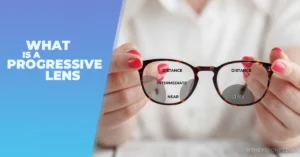|
Getting your Trinity Audio player ready...
|
Introduction
Progressive lenses, also known as multifocal lenses, are innovative eyeglasses designed to provide clear vision at various distances without the visible lines typically associated with traditional bifocals or trifocals.
As we age, our eyes lose the ability to focus on nearby objects, a condition called presbyopia.
Progressive lenses address this issue by featuring a gradual change in lens power, allowing wearers to seamlessly transition between near, intermediate, and distance vision.
These lenses are a fantastic option for people with presbyopia, offering a natural and convenient solution. With progressive lenses, there’s no need to carry around multiple pairs of glasses anymore. Plus, they provide a super comfortable visual experience!
What is Presbyopia?
Definition and Explanation of Presbyopia
Presbyopia is a common age-related vision condition that affects individuals around the age of 40 and older. It occurs when the lens in the eye loses its flexibility, making it difficult to focus on near objects.
Symptoms of Presbyopia
People with presbyopia often experience symptoms such as difficulty reading small print, eyestrain, and headaches when performing close-up tasks such as reading, using a smartphone, or working on a computer.
Causes of Presbyopia
Presbyopia is a common eye condition that’s associated with getting older. It happens when the lens in your eye becomes less flexible and the muscles around it weaken. As a result, it becomes harder to focus on things that are close up, like reading or using your smartphone. This gradual loss of near vision usually starts around the age of 40, and more than half of the population will experience these symptoms.
How Do Progressive Lenses Work?
Definition and Function of Progressive Lenses
Progressive lenses are a type of multifocal eyeglass lens that provides clear vision at all distances without the visible lines of traditional bifocals or trifocals.
These lenses have a seamless progression of added magnifying power for intermediate and near vision, allowing wearers to see clearly whether looking far away, up close, or at arm’s length.
Progressive lenses are ideal for those with nearsightedness and farsightedness, but there is a learning curve involved as the brain needs to adapt to the new way of seeing.
How Progressive lenses differ from bifocal and trifocal lenses
Traditional bifocal and trifocal lenses have visible lines that divide the lens into different sections for near, intermediate, and distance vision.
These lines can be distracting and make the transition between different distances less smooth.
The technology behind progressive lenses involves a gradual change in lens power from the top to the bottom without any visible line.
The top portion of the lens is designed for distance vision, while the bottom portion is meant for near vision. The middle section provides the intermediate vision needed for activities like using a computer or reading a menu.
How progressive lenses address presbyopia
Progressive lenses are like superheroes for anyone dealing with presbyopia. They smoothly transition between different lens powers, giving you clear vision at all distances.
From your distance prescription at the top to the full reading addition at the bottom, these lenses gradually increase in power, allowing you to see both near and far without switching between multiple pairs of glasses.
Benefits of Progressive Lenses
Seamless Transition between Prescription Powers
Progressive lenses provide a seamless transition between different prescription powers, allowing wearers to see clearly at varying distances without the need to change glasses.
Unlike traditional bifocals and trifocals, which have visible lines separating the different prescriptions, progressive lenses offer a smooth and continuous field of vision.
This design makes progressive lenses a versatile and natural-looking option for correcting presbyopia and other vision problems, ensuring that wearers can comfortably perform tasks at different distances with ease.
Clear Vision at All Distances
Progressive lenses are a great solution for those who need clear vision at all distances.
With multiple prescriptions in one pair of glasses, progressive lenses allow individuals to see close-up, intermediate, and distant objects without the need to switch frames or take off their glasses.
This seamless transition between different powers in the lens surface ensures that wearers can enjoy clear vision no matter what task they are performing.
Improved Aesthetics and No Visible Lines
In addition to providing clear vision at all distances, progressive lenses also offer an aesthetic advantage.
Unlike traditional bifocals and trifocals, progressive lenses do not have visible lines that can be seen on the lens surface.
This creates a more natural and appealing look, making progressive lenses a popular choice among those who want to maintain a stylish appearance while still correcting their vision.
Enhanced Field of Vision and Depth Perception
Furthermore, progressive lenses can improve the field of view and depth perception for wearers.
By seamlessly blending different powers across the lens surface, progressive lenses provide a more natural and enhanced visual experience.
This enhanced field of view and depth perception can improve overall visual comfort and performance in various tasks, making progressive lenses a versatile and practical choice for those in need of multifocal correction.
Choosing the Right Progressive Lenses
Factors to Consider when Selecting Progressive Lenses
When it comes to choosing progressive lenses, there are a few things you should keep in mind.
First, consider the cost, as progressive lenses do tend to be a bit pricier than single-vision or bifocal lenses.
However, the convenience and versatility they provide might just be worth the extra investment for some people.
It’s also important to know that there may be an adjustment period when you first start wearing progressive lenses.
You might experience some discomfort or vision issues initially but don’t worry, it’s completely normal.
Just give yourself some time to get used to them and you’ll be enjoying clear vision in no time.
Oh, and don’t forget about visual effects too, like peripheral distortion. It’s good to be aware of these factors when making your decision.
Lens Designs and Options
When it comes to lens design and options, progressive lenses offer a seamless progression of added magnifying power for intermediate and near vision.
These lenses have a gradual change in lens power from the top for distance vision, to the center for intermediate vision, and finally to the bottom for reading vision.
This design allows for clear vision at all distances without the visible lines associated with bifocals or trifocals.
Working with an Eye Doctor to Determine the Right Progressive Lenses
Getting the right progressive lenses for your needs is crucial, and that’s where your friendly eye doctor comes in! They’ll take into account your prescription, lifestyle, and vision requirements to suggest the perfect progressive lenses for you.
Plus, they’ll walk you through the adjustment period and talk about any potential visual effects, so you can enjoy a comfortable and effective eyewear solution.
Adjusting to progressive lenses
Learning Curve and Adaptation Period
Learning how to adjust to progressive lenses can take some time and patience. It is important to wear the lenses as often as possible in the beginning to help your eyes adapt to the different focal zones. Initially, you may experience visual distortions in your peripheral vision or feel dizzy or nauseous, but these symptoms are usually temporary. It is recommended to follow your eye doctor’s instructions and advice and communicate any issues you may be having with adapting to your progressive lenses. With practice and guidance from your optometrist, most people can successfully adjust to and benefit from wearing progressive lenses.
Care and maintenance of progressive lenses
Cleaning and Proper Handling of Progressive Lenses
Taking good care of your progressive lenses is essential to keep them in pristine condition. Here are some friendly tips on how to clean and handle your lenses properly:
1. Gentle Cleaning Solution: Choose a gentle lens cleaning solution to clean your progressive lenses. This will help prevent any scratches and keep them looking crystal clear.
2. Microfiber Cloth: When wiping your lenses, always use a soft microfiber cloth. This will ensure that you don’t leave any smudges or fingerprints behind.
3. Handle with Care: When holding your lenses, make sure to hold them by the frame. This will help prevent any unwanted marks or fingerprints on the lens surface.
4. Say No to Harsh Chemicals: Avoid using harsh chemicals or rough materials that can damage the lens coating. Stick to gentle cleaning solutions and soft cloth for the best results.
5. Protective Case: When you’re not using your glasses, keep them safe in a protective case. This will protect them from accidental damage or scratches.
Remember, regular cleaning and proper handling are the keys to maintaining the clarity and longevity of your progressive lenses. So treat them well, and they’ll continue helping you see the world.
Advantages of a Progressive Lens
Progressive lenses offer clear vision at all distances, eliminating image jumps and providing a smooth visual experience.
They also offer aesthetic appeal, simplifying eyewear routine.
Furthermore, they improve posture and cater to computer vision.
In conclusion, progressive lenses provide enhanced visual comfort and versatility in a single pair of glasses.
Disadvantages of a Progressive Lens
Progressive lenses have pros and cons. One drawback is the adjustment period.
Users may struggle to find the right focal point initially, causing temporary discomfort.
Another disadvantage is visual distortions in the lens periphery.
Rapid head movements make this distortion noticeable.
The cost of progressive lenses is also higher than other types.
Despite these cons, the benefits of clear vision and a sleek design make them worth it for many.
QNA
Is progressive lens good for eyes?
Progressive lenses help with multiple vision distances, reducing eye strain and discomfort. They transition seamlessly between near, intermediate, and far distances, eliminating the need for multiple pairs of glasses. This provides a natural and clear vision correction solution. They also offer cosmetic benefits by removing visible bifocal or trifocal lines, making them a popular discreet eyewear choice.
Which lens is better, progressive or bifocal?
Progressive lenses are superior to bifocal lenses. They provide a smooth transition between prescription strengths, eliminating the annoying jump of bifocals. They also improve posture and allow for natural head movement. Additionally, they offer a wider range of clear vision for different distances, making them versatile for various activities. Progressive lenses use advanced technology for a more comfortable and functional vision solution compared to bifocals.
What is the difference between a progressive lens and a normal lens?
Progressive lenses have multiple prescription strengths in one lens, providing clear vision at various distances. Normal lenses only have one prescription strength and are designed for either distance or near vision. Progressive lenses transition between focal points seamlessly, while normal lenses cannot. They are ideal for age-related farsightedness or presbyopia, while normal lenses suit specific vision needs at one distance.
What is the purpose of progressive lenses?
Progressive lenses give clear vision at varying distances for those with presbyopia or myopia. They offer multiple focal points without visible lines, allowing for seamless transitions between near, middle, and far distances. These lenses correct vision problems like presbyopia, astigmatism, and blurry vision, making it convenient to have just one pair of glasses for different tasks. They provide a natural and versatile solution for individuals needing vision correction at multiple distances.








